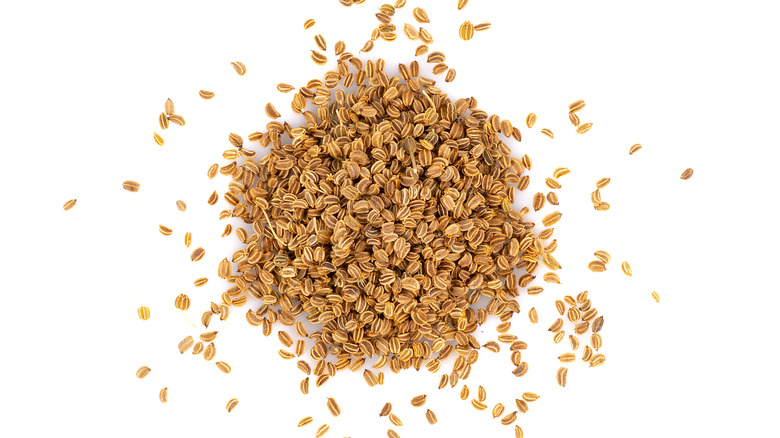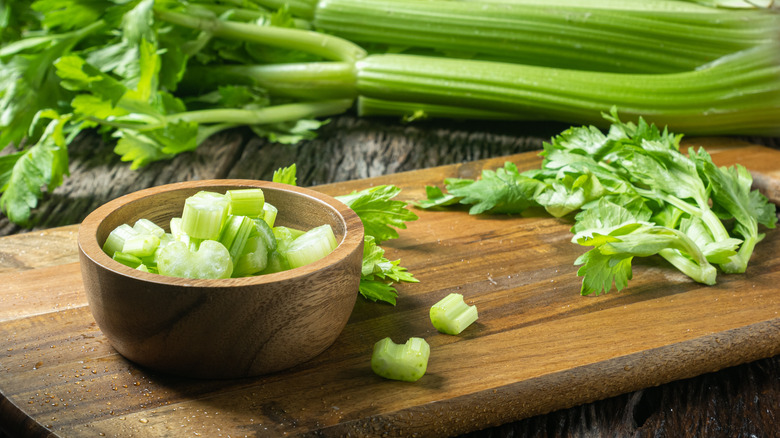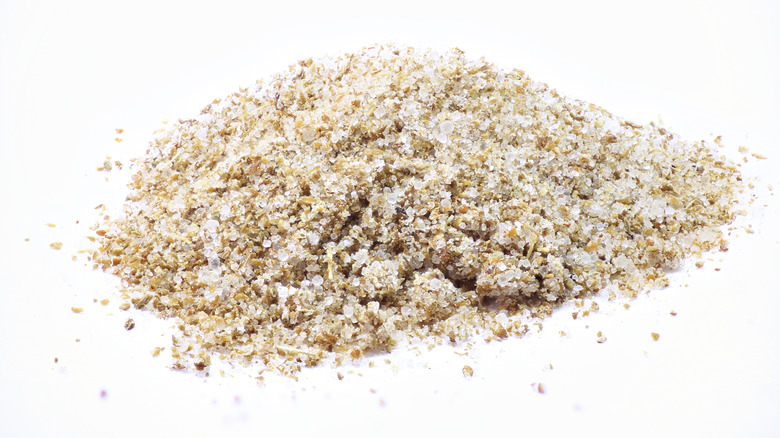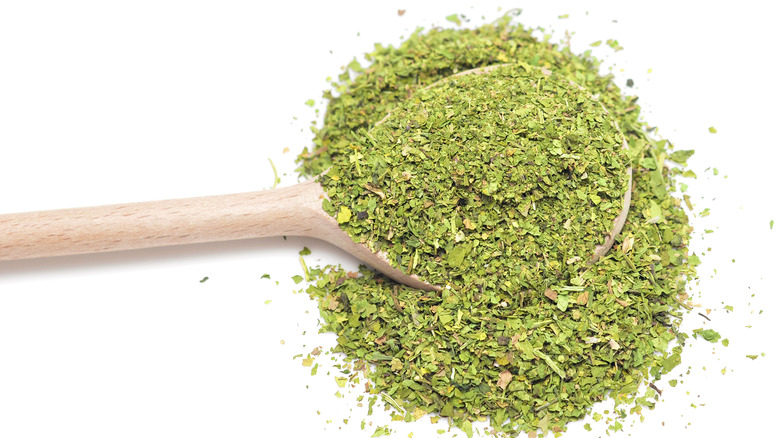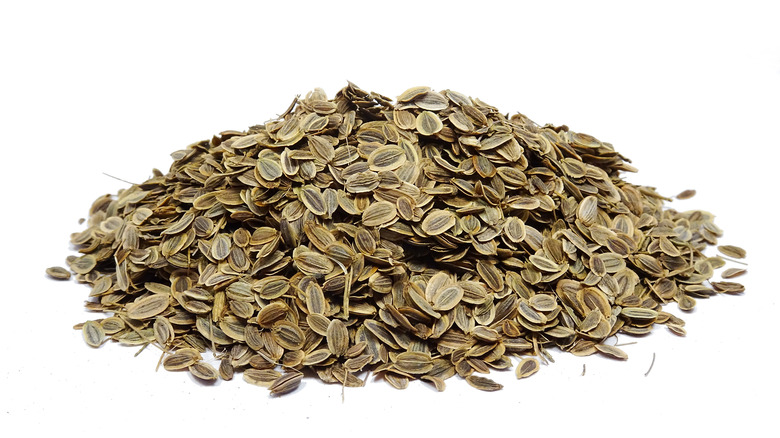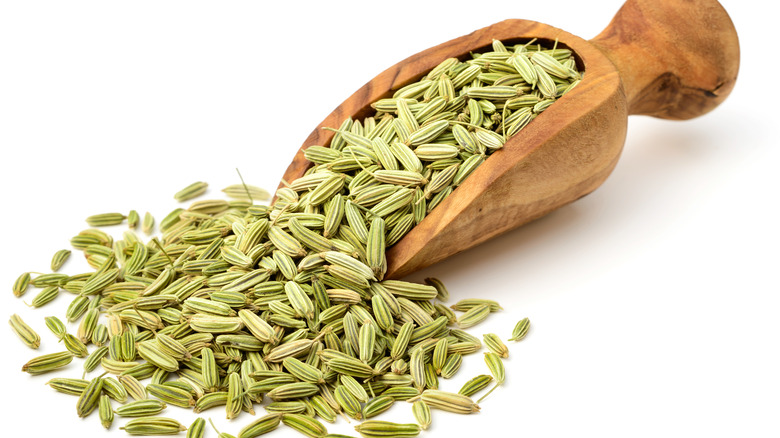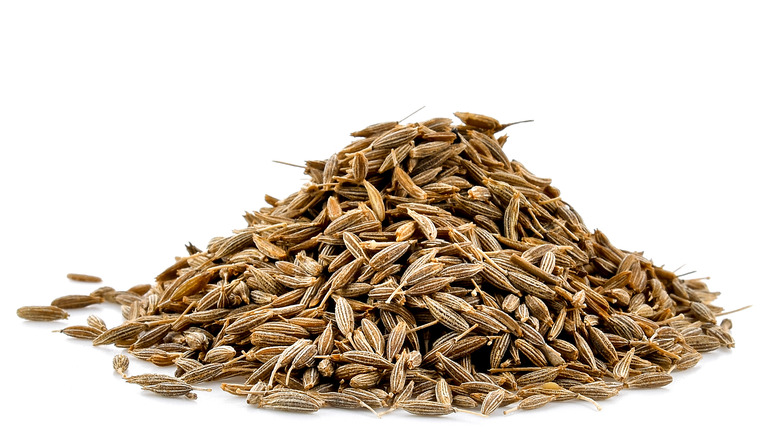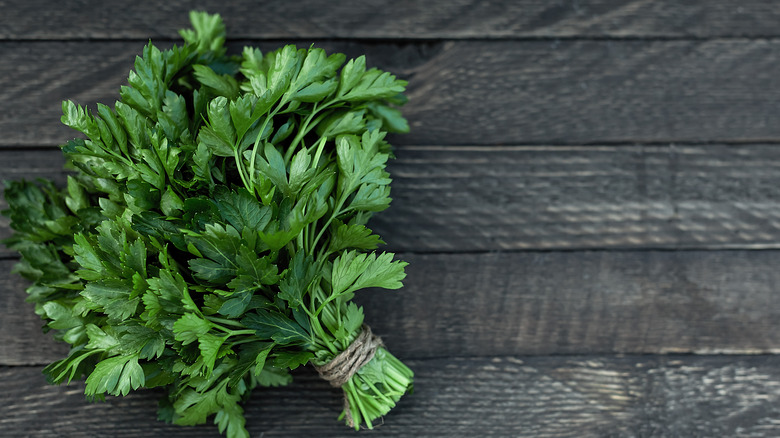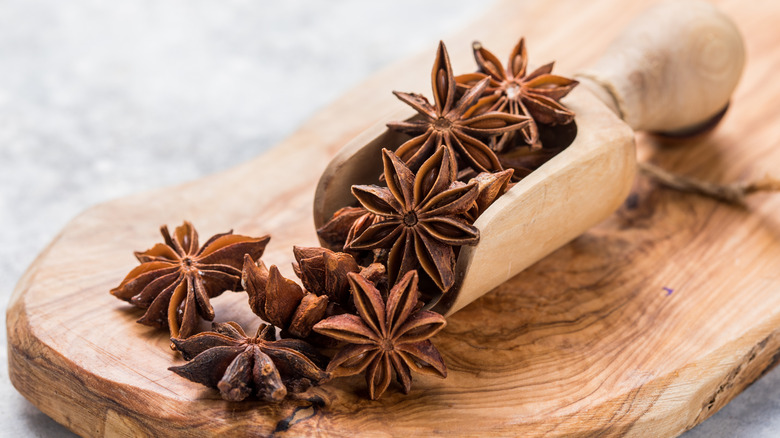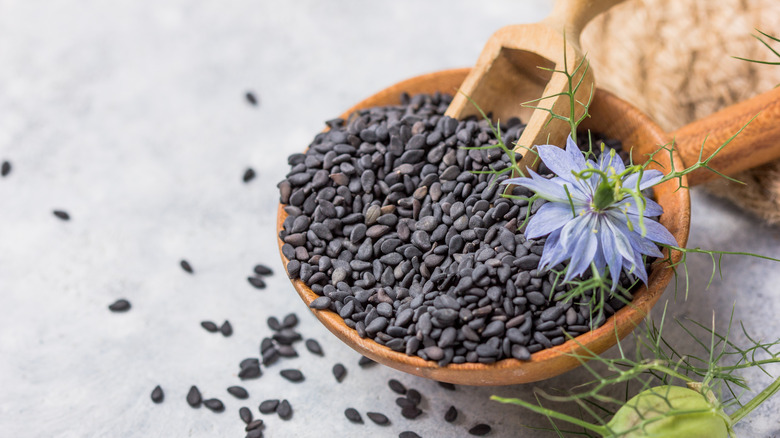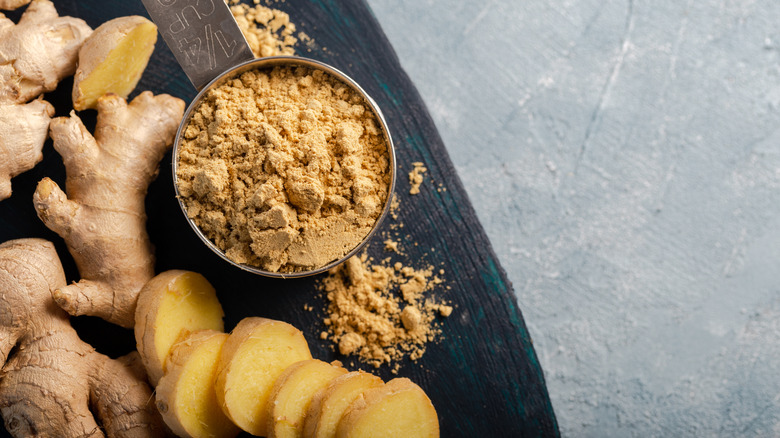10 Best Substitutes For Celery Seeds
You're likely familiar with the crunchy green celery stalks found on so many crudite platters and as the base of so many soups and stews, but that's not the only tasty celery-based ingredient to have in your kitchen. While they aren't quite as common and widely used as some other spices, celery seeds are a flavorful spice that can be incorporated in a wide variety of dishes. They impart a unique flavor — for those who haven't yet tried them, the seeds have a few similarities to raw celery stalks, offering a particular aroma and a bit of astringency, according to The Spruce Eats. You can find them in two forms, ground and whole, and both have their uses. While you do need to be careful about the amount you use, as it can have some unpleasantly bitter notes if used in excess, it's a great spice to add to your collection.
However, if you find yourself making a recipe that calls for celery seeds, and you don't yet have them on hand, don't worry, there are plenty of substitutes that do a great job of mimicking the flavor profile of celery seeds and enhancing your dish. Here are just 10 spices to consider if you're looking to substitute celery seeds in a particular recipe.
1. Celery stalks and leaves
When it comes to replicating that unique celery flavor, one of the first places that people may think to look is another part of the same plant. As it runs out, celery stalks and leaves can serve as a great substitute for celery seeds (via Richard's Pantry). Though their flavor isn't quite as intense as the seeds, they still bring a lot of the same flavor notes into whatever dish you're using them in.
There are just two major considerations when it comes to using this substitute. First of all, the texture is vastly different — rather than compact little seeds, you're using the crunchy stalk, the flat leaves, or both. In dishes where texture is important, this could be a major issue. However, in some dishes where there's a bunch of different ingredients, like a vegetable stew, the celery stalks and leaves may work out just fine. In order to counteract the difference in texture, you'll want to dice the celery stalks and leaves as finely as you're able to, in order to more seamlessly integrate them into your dish. The other thing to consider is the amount needed. Since the stalks and leaves are less intense in flavor than the seeds, you need a lot more — we're talking six times the amount. For best results, you'll want to use about 6 tablespoons of celery stalks or leaves for every 1 tablespoon of celery seeds that your recipe calls for.
2. Celery salt
If you've ever wondered about the difference between celery seeds and celery salt, it's very simple. Celery salt is just a mixture of celery seeds and salt, creating a flavorful, salty seasoning to add to any recipe (via Richard's Pantry).
The fact that celery salt contains celery seeds means it's just about the best substitute you can think of, since it actually contains the flavor you're trying to mimic. However, the one major consideration when using this substitution is the overall salt content. Since salt is obviously a major component of celery salt, you'll want to examine the salt content in your dish before adding it. Depending on the amount of celery seeds a recipe calls for, you may want to entirely eliminate any added salt, and just have the salt found in the celery salt substitute. For best results, as long as you keep an eye on that sodium content to avoid overpowering your dish, you can do a direct swap, using 1 teaspoon of celery salt for a recipe that calls for 1 teaspoon of celery seeds.
3. Celery flakes
The fact that celery is available in so many forms makes finding substitutes easy, as you can just gauge which particular type of celery product would work best in your recipe. One great substitute for celery seeds is celery flakes, which are just a dried version of celery leaves (via Leaf TV). The consistency between the two are very different, as celery seeds come in compact little seeds, while the flakes look like many other dried herbs you may have in your spice collection. This may be an issue if the celery seeds are being used as a garnish in your dish or incorporated visibly somehow, but if they're just another ingredient mixed into a sauce, dressing, soup or similar recipe, you should be just fine, as the flavor notes are very similar.
As you may be familiar with from using other herbs, dried herbs tend to have a much stronger, more concentrated flavor than their fresh counterparts, and the same is true for celery flakes. They have a more intense flavor than celery leaves, so you don't need to use quite as much to get that celery flavor, although you still need more than you would celery seeds. For best results, you should triple the amount called for in your recipe if using this substitution — so, if your dish requires a tablespoon of celery seeds, you would swap that with 3 tablespoons of celery flakes.
4. Dill seeds
Dill seeds and celery seeds are different in terms of their appearance, with dill seeds being a bit wide and flat, almost resembling flax seeds, and celery seeds darker and more compact. However, the two actually have quite a few similarities in terms of flavor, which is one of the most crucial components when making a recipe substitution (via Food Shark Marfa).
Dill seeds are used in many similar types of recipes as celery seeds, such as pickling. According to Serious Eats, this substitute is particularly well suited to Eastern European cuisine and really shines in dishes that pack some serious acidity (which is why they're so great for pickling). As an added bonus, you can be quite versatile in your preparation method — dill seeds can easily be toasted or cooked in broth, and since they plump up a bit in liquid, you don't need to grind them up. For best results, according to Spiceography, you can do a direct swap — so, for a recipe that calls for a teaspoon of celery seeds, you can substitute a teaspoon of dill seeds.
5. Fennel seeds
Anyone who has ever eaten a dish with fennel knows that it has a unique flavor profile, with some distinct licorice flavor notes. Fennel seeds have an even more concentrated flavor, as most seeds do, and are incredibly aromatic, making them a great addition to many dishes — and a great substitute for celery seeds in a recipe when you need one (via Chef's Pencil).
Their unique flavor, slight hint of sweetness, and aromatic nature means that fennel seeds are a wonderful ingredient in complex dishes with a lot of layered flavors like curries, soups and stews. They're also particularly well suited to spice marinades for meat, if you're looking to level up your grilling game with some carefully crafted spice blends. If you're making a rub with fennel seeds, though, you may want to consider grinding them to allow all your spices to blend a bit more easily. For best results, you can do a direct swap, using a teaspoon of fennel seeds in place of a teaspoon of celery seeds in a recipe.
6. Caraway seeds
Caraway seeds are known for their unique licorice flavor notes, but they are actually a surprisingly good substitute for celery seeds (via Richard's Pantry). Caraway seeds have hints of bitterness and nuttiness that are also found in celery, as well as some of the same herbal flavor notes.
These seeds look a bit different — they're a brownish hue and a bit more long and narrow in comparison to celery seeds — but when mixed into a dish, you shouldn't even be able to tell. The unique flavor of caraway seeds means this substitute is particularly well suited to dishes like cold salads, and it also goes extremely well with any kind of Eastern European fare, as many of those dishes contain caraway seeds as a flavor agent. For best results with this substitute, you can do an equal swap — a recipe that calls for a teaspoon of celery seeds would receive a teaspoon of caraway seeds instead.
7. Parsley
Celery tends to have a bit of a herbaceous, aromatic component to it, which is why parsley can be a surprisingly good substitute for celery seeds (via Substitute Cooking). Parsley is an ingredient that can be easily found in just about any supermarket. However, you'll want to use the fresh herb if you're swapping it out for celery seeds, as dried parsley just doesn't pack the same flavor punch.
Parsley has some peppery flavor notes and also a hint of freshness that adding fresh herbs always incorporates. There's just one thing to note with this particular substitute — the proportions. In order to best replicate the strong flavor of celery seeds, you'll need to increase the amount of seasoning added. So, for best results, you'd use approximately 3 tablespoons of fresh parsley for every 1 teaspoon of celery seeds called for in the dish you're making (via Gourmet Sleuth). In some dishes, this may not be an issue; in others, you may need to consider how adding that amount of fresh parsley will change the overall appearance. After all, you eat with your eyes first — large flecks of green parsley may add a rustic vibe to some dishes, but may ruin the overall effect of a silky sauce, so take a moment to consider the recipe you're making with this particular substitute.
8. Star anise
You may recognize star anise by its signature cluster of cloves that create a star-like shape. This versatile spice can be used in a wide variety of recipes and is particularly well-suited if you're looking to substitute celery seeds in Asian cuisine (via Richard's Pantry).
Star anise has a flavor profile that contains some licorice notes as well as a little sweetness, and it works well to enhance many types of dishes. There are just two key considerations when making this particular substitution. First, it's unpleasant to bite down on a whole star anise pod, so you may want to consider either grinding this spice or otherwise placing it in a mesh bag of some sort, which can be easily removed once the spice has flavored your dish, the same as you would for a bouquet garni (via The Spruce Eats). Additionally, star anise has a very powerful flavor, so you'll want to be quite light-handed with this spice. For best results, you'll want to use about half the amount of star anise as you would have used celery seeds — so, you'd add a half teaspoon of star anise for every 1 teaspoon of celery seeds in your recipe.
9. Nigella seeds
Nigella seeds, also known by alternative names such as kalonji and black cumin, make a great substitute for celery seeds (via Healthier Steps). They have a hint of sweetness and some of those licorice flavor notes found in ingredients like caraway, and the complexity of flavor within these little black flecks goes well with a wide variety of dishes.
The one downside to Nigella seeds is that they can be a bit challenging to find in regular grocery stores. However, because of their popularity in Indian cuisine, you should have no issue scooping up a package in an Indian market or grocer. You'll also want to be mindful of the appearance. While it may not matter in some dishes, in others, you may not want to have little black specks throughout your otherwise creamy white sauce, etc. For best results, when using this substitute, you can do a direct swap — so, for a recipe that requires a teaspoon of celery seeds, you could add in a teaspoon of Nigella seeds without significantly changing the flavor profile of the dish.
10. Ginger
While ginger and celery may seem like completely different flavors, this warming spice can actually serve as quite a good substitute for celery seeds, particularly in dishes with strong flavors like Asian cuisine (via The Home of Cuisine). Ginger has some peppery flavor notes and a pungency that allows it to enhance a wide variety of dishes, although it's particularly well-suited to stir-fry, curry, and marinades (via Substitute Cooking).
While you can certainly use ground ginger, fresh ginger will often add a whole different depth of flavor to your dish, and it's not difficult to simply grate off a small amount. One bonus for this particular substitute is how easily accessible it is — most grocery stores will have those gnarled hunks of ginger root in their produce section. Since ginger can be overpowering, for best results, you may want to start with substituting half the amount called for, and then adjusting according to taste. So, a recipe that requires a teaspoon of celery seeds would receive a half teaspoon of grated ginger to start, with the potential of more if you think the dish can handle it.
